Printable Sites Overview Itinerary & Daily Costs
Kanazawa
Day 3
August 2, 2022
Kanazawa, capital, Ishikawa ken (prefecture), central Honshu, Japan. It is situated on the Sai River, at the river’s mouth on the Sea of Japan (East Sea). In the 16th century, the city and the province of Kaga were given to the Maeda family, the wealthiest clan of daimyo (hereditary rulers) during the Edo (Tokugawa) period (1603–1867). Kanazawa remained under Maeda jurisdiction for approximately 300 years. The walls, gates, and a few buildings of the family’s castle remain, giving the city the atmosphere of traditional Japan. Kenroku Garden, formerly on the Maeda estate, is an excellent example of Japanese landscape gardening. Manufacturing developed from Kanazawa’s luxury industries of fine lacquer and Kutani ware porcelain. An ancient silk industry has been expanded to include cotton, woolen, rayon, and nylon textiles. (Britannica, T. Editors of Encyclopaedia (2018, May 22). Kanazawa. Encyclopedia Britannica. https://www.britannica.com/place/Kanazawa)
Kanazawa Station
We start and end our day trip at Kanazawa Station. Kanazawa Station is housed inside a well-organized, modern building which also contains many shops, restaurants, and also a hotel. On either side of the building are pleasant plazas which are popular meeting spots and the design of the east plaza in particular with its huge gate and dome has made the station itself a popular tourist attraction.

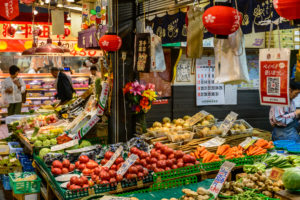
Omicho Market
Omi-cho Market is our brunch-time destination. Omicho Ichiba is a lively covered food market which has been in operation since 1721. Nicknamed “Kanazawa’s kitchen”, here you will find 186 different stores, selling seafood, fresh fruit and vegetables, and confectionery. There are also a number of grocery stores, clothing stores, flowers stalls, and restaurants. The market has a very cheerful atmosphere and is a great place to explore Kanazawa’s food and drink culture.
Oyama Shrine
Oyama Jinja Shrine was originally established in the Utatsuyama area of Kanazawa in 1599. At that time it was called Utatsu Hachimangu Shrine. It was moved to its current location in 1873 and renamed Oyama Jinja. The Oyama Shrine gate dates from 1875 and is unusual as it shows a mixture of Japanese, Chinese, and European styles. It was designed by a Dutch man named Holtman, and is most famous for the Dutch style stained glass windows on the 3rd floor. There is a story that this top part of the gate was originally used as a light house. Though the gate was unpopular when it was first built, in 1950 in recognition of its unique style it was officially designated as an Important Cultural Asset.
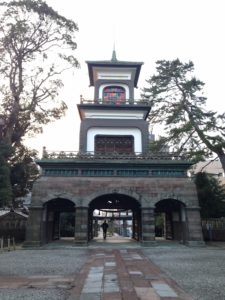
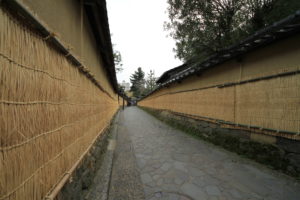
Nagamachi Samurai District
Nagamachi Samurai District is a beautifully preserved historic area of Kanazawa that was once the residential district for the city’s samurai. It is a lovely area of canals and stone-flagged winding lanes that run between tile-topped earthen walls. Some of the former samurai houses and their gardens are also open for public viewing.
Ishikawa Local Products
The Ishikawa Local Products Center is located close to Kenrokuen, one of the three most beautiful gardens in Japan. It is a commercial facility that offers local specialties and craft products such as confections that are famous or are produced by long-established shops, tsukuda-ni (seafood/meat/seaweed simmered in soy sauce and sugar), and traditional crafts. They also offer some wonderful hands-on crafting experiences that I am sure you will enjoy!
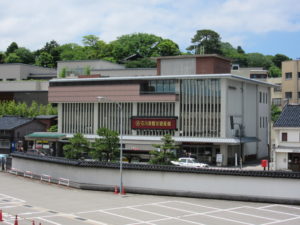
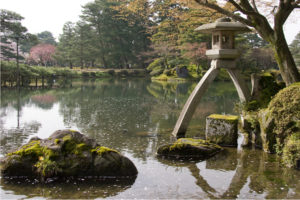
Kenroku-en
Kenrokuen is a gorgeous and expansive park-like garden in the center of Kanazawa and it is the city’s major attraction. Extending over almost 25 acres, it was once the outer garden of Kanazawa Castle but was opened to the public in 1874. Kenrokuen is considered one of the Three Great Gardens of Japan. Here you will find colorful seasonal floral displays, streams, ponds, waterfalls, stone lanterns, and historical tea houses.
Seisonkaku Villa
Seisonkaku Villa, which stands inside Kenrokuen Garden, was built in 1863 by Nariyasu Maeda, the 13th lord of the Kaga clan who ruled Kanazawa. He built it as a retirement home for his mother, Takako who was later called Shinryuin. Because she was going to spend a lot of time in this house, a lot of effort was put into decorating the interior. Around the house you will find delicate paintings on screens and walls, stained glass which was specially imported from Europe, and finely carved latticework. Every detail is dedicated to the appreciation of beauty. Ornate family heirlooms, dolls and kimonos are also on display. Because both the house and its furnishings are so well preserved it is today a nationally designated Important Cultural Property.
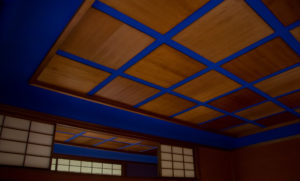
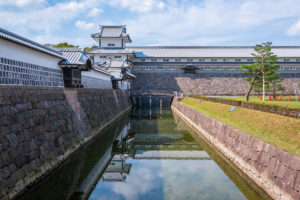
KanazaWa Castle
Kanazawa Castle stands in substantial park grounds in the center of Kanazawa City, and is just across the road from Kanazawa’s other big attraction, Kenrokuen Garden. The castle has played a central role in Kanazawa’s history and though once neglected, it has been extensively rebuilt and renovated in recent years.
The park itself is free to enter and parts of the castle can also be freely explored. For a small fee you can also enter some of the reconstructed buildings and learn how the castle was constructed as well enjoy the view from the castle windows. It is an essential stop on any tour of the city.
Higashi Chaya District
Higashi Chaya District is a beautifully preserved historical area of Kanazawa with many traditional wooden buildings. This area was established in 1820 as an entertainment district for rich merchants and nobility.
The name Higashi Chaya-gai literally means “Eastern Teahouse District,” because the chaya, or teahouses, were where wealthy customers would be entertained by geisha with traditional music, dancing, and drinking games. Many of these buildings have today been converted into restaurants or souvenir craft shops, but there are two geisha teahouses that are open to the public during the day.
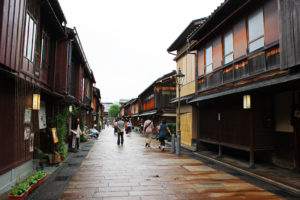
Optional Destinations in Kanazawa
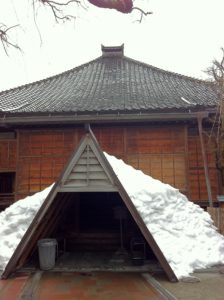
Ninjadera
Myoruji Temple is often called “the Ninja Temple” because of its many trap doors and secret passageways. Actually, the temple has no connection with the historical ninja who were spies and assassins. However, its unique architecture and history makes it a fascinating location to visit.

Nishi Chaya District
The Nishi Chaya District is one of the three geisha (traditional female Japanese entertainers) districts of Kanazawa. Chaya is a traditional place of feasts and entertainment. You can find a number of two-story wooden chaya houses along the main street. At the time of twilight, you may hear the sound of the shamisen (a three-stringed musical instrument) and strongly feel the atmosphere of the Kanazawa-like chaya machi.
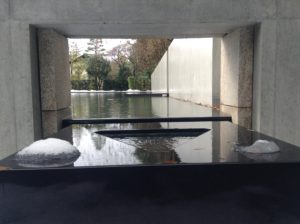
D.T. Suki Museum
The D. T. Suzuki Museum was opened in 2011 to commemorate and celebrate the life and work of Suzuki Daisetz Teitaro (1870-1966) an important Japanese Zen philosopher who was born in Kanazawa. The museum is not only a place to learn about Suzuki’s life and thinking, but in its structure it puts Zen thought into practice and there is a special area where visitors can sit quietly and meditate. The museum is not very big, but is well worth visiting as a place to learn more about Zen and also to enjoy the graceful modern architecture.
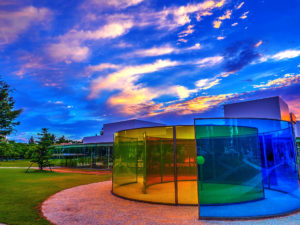
21st Century Museum
Kanazawa’s 21st Century Museum of Contemporary Art opened in 2004 and was designed by two famous Japanese architects: Kazuyo Sejima and Ryue Nishizawa of the SANAA architecture studio. They created a low-lying and expansive, white, circular building that looks very much like a giant space ship that has landed quite neatly on the grass lawn that surrounds it. The museum has no main entrance and can be entered from all sides. This accessibility is emphasized by the glass walls that surround the museum’s exterior and which flood the galleries with natural light. Inside the museum many galleries are arranged in a puzzling maze of interconnecting rooms, which encourages a playful sense of exploration and discovery.

